Artificial Intelligence (AI) is one of the most popular technology-related terms today. According to Google Trends, searches for this term increased 20-fold over a year and a half (December 2021 to July 2023), as shown in Figure 1.
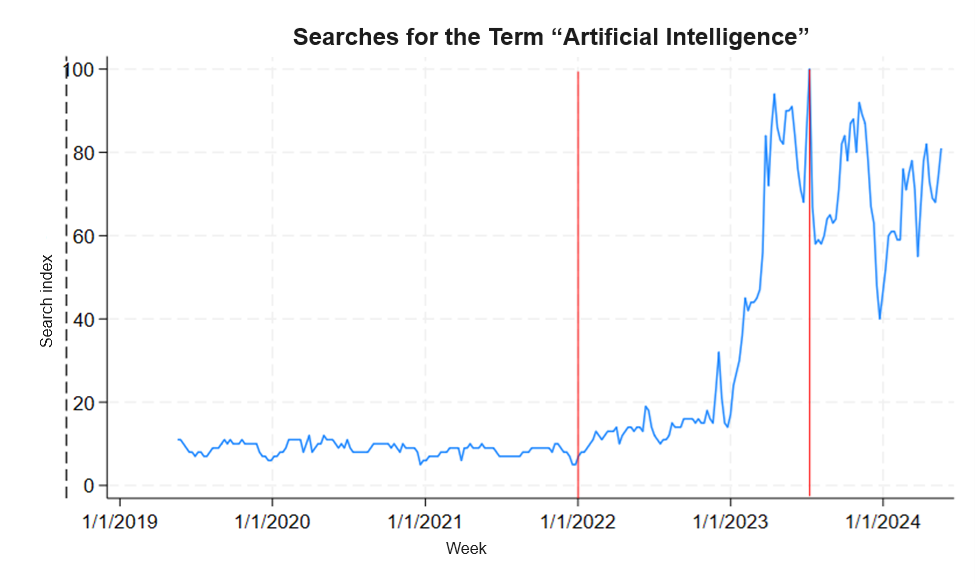
Generative Artificial Intelligence (GAI) is often described as:
- A field of computer sciences that emulates processes inherent to human intelligence
- Large Language Models (LLMs)
- A technology capable of creating unique and original content
- The new industrial revolution.
GAI aims to emulate human intelligence capabilities to create content after having been trained with large amounts of data. This is why the Inter-American Development Bank (IDB), in its publication Tech Report: Generative AI, defines GAI as a “type of Artificial Intelligence (AI) that uses machine learning to produce new content from a large set of training data. The result format can be text, images, video, code, 3-D renderings, or audio.”
It is evident that a technology with these characteristics can be a great help to human beings. GAI facilitates speeding up routine tasks and is useful in academic and professional fields. However, it is important that users recognize the limitations of its use in relation to the precision of the content, automation of the creative process, use of the language, and ethical implications.
In the professional scope, there are many fields that can benefit from this technology. In this blog we will focus on the environmental and social areas, with particular emphasis on tasks that may arise for an environmental and/or social specialist. However, Let’s Talk About Sustainability and Climate Change also has other blogs on technology: Business Intelligence and Big Data: What Are the Opportunities for Sustainability?
Aspects to Consider as a GAI User
- GAI is a tool capable of generating new content. It does not replace conventional search engines. GAI analyzes the information, synthesizes it, and presents it in a new format. In contrast, search engines use a different technology that allows for extracting specific information from a large database without producing new information. However, GAI results can include errors, technically known as hallucinations. A hallucination in GAI occurs when the response generated is not correct. This can happen, for example, when we ask a question, and this technology produces an answer with inadequate information. There are many reasons for this, which is why it is always important to review the content provided to us, and to request the sources of information and references used.
- The ethical implications of GAI regarding the storage and reproduction of information.
- Information security: When working with data that may contain private information, we must be careful about sharing it with public GAI tools. For example, if we want to use GAI to speed up preparation of terms of reference for contracting, we should consider financial information of the bank that is not public, as well as the personal information of individuals involved in the contracting process.
- Information ownership: Another example involves the reproduction of information in a way that passes it off as one’s own work when in fact it is generated by GAI. References should be requested from the original authors to cite their work.
- Bias: It is the reproduction of erroneous and potentially harmful results due to distortions in the original training data or the GAI algorithm. For example, asking a question about a racial issue without properly constructing the question can result in the question being biased from the start. Consequently, it is likely that the response will be framed within the discriminatory parameters of the question itself and simply confirm the prejudice (confirmation bias). Another possibility could be that the GAI training data already includes biases.
- Information security: When working with data that may contain private information, we must be careful about sharing it with public GAI tools. For example, if we want to use GAI to speed up preparation of terms of reference for contracting, we should consider financial information of the bank that is not public, as well as the personal information of individuals involved in the contracting process.
That said, it is important to understand that GAI should contribute to a creative personal and business process and not replace it. Below are several tips and prompts (instructions provided that describe the tasks to be performed) to interact with GAI, improve its productivity in an ethical manner, and at the same time respect the use of private information.
Recommendations for an ESG Specialist on Giving Instructions to GAI
Write as if you were having a conversation with your assistant and giving the assistant instructions for a task. Provide a context or introduction, then state what you are looking for and where you are looking for it (if you already have a defined source in mind). Finally, outline your needs. All of this in clear and concise language, like this:
- How to improve a prompt for environmental legal frameworks

- How to improve a prompt for social and environmental impacts and risks
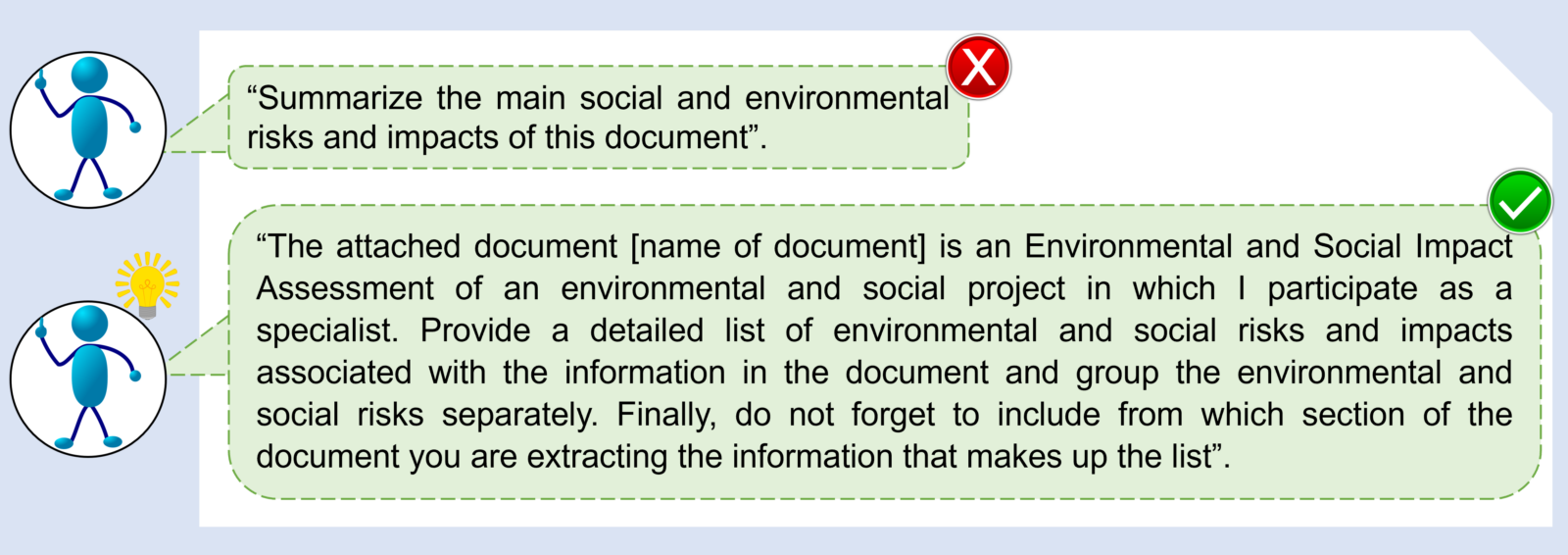
Specify the expected output format in detail, as shown below:
- How to give instructions on output formats
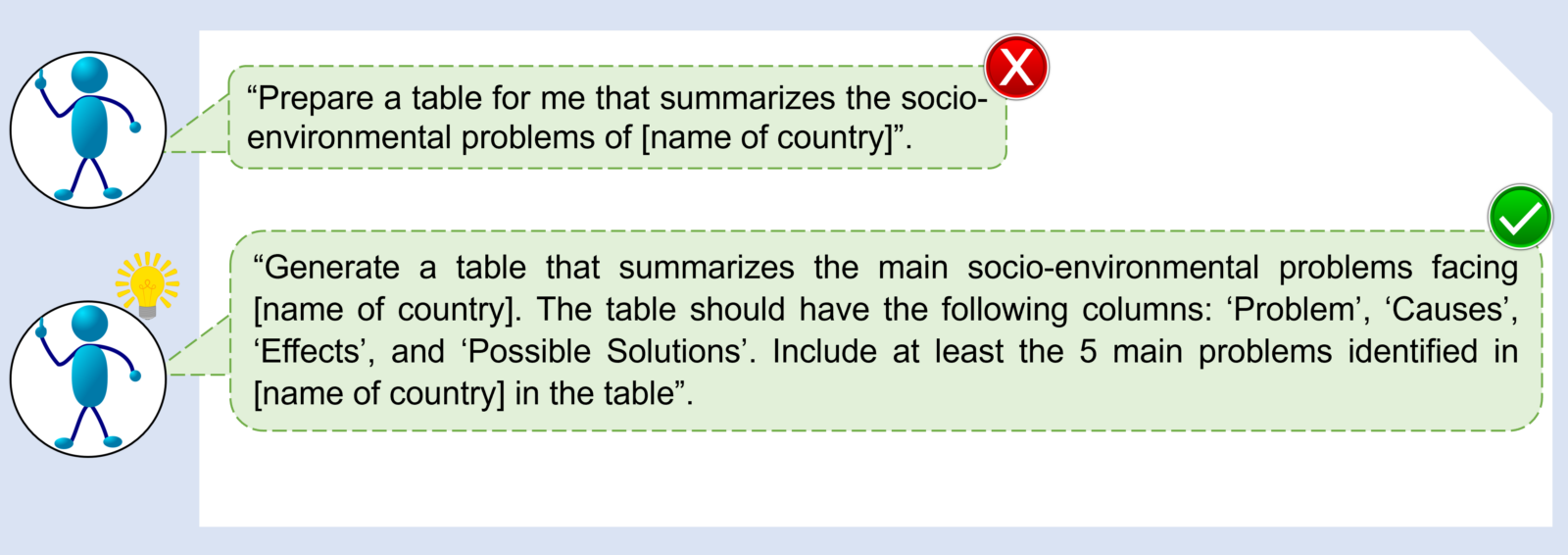
- How to interact with GAI to get precise instructions on the information required for a specific format

Based on the information that GAI requires, you can make different iterations and provide feedback to reach a draft that meets your needs.
Review carefully the information provided by the GAI. Based on the responses you receive, you can refine or rephrase your questions to obtain more accurate responses. Critical thinking is crucial when interacting with GAI. Therefore, as the conversation progresses in the search for the optimal response, you should generate clearer and/or different instructions in subsequent iterations to refine the final answer. Remember that GAI learns and adapts through the contextual information you provide.
- For example, you may encounter this non-optimal interaction when requesting that GAI generate a paragraph on a topic:
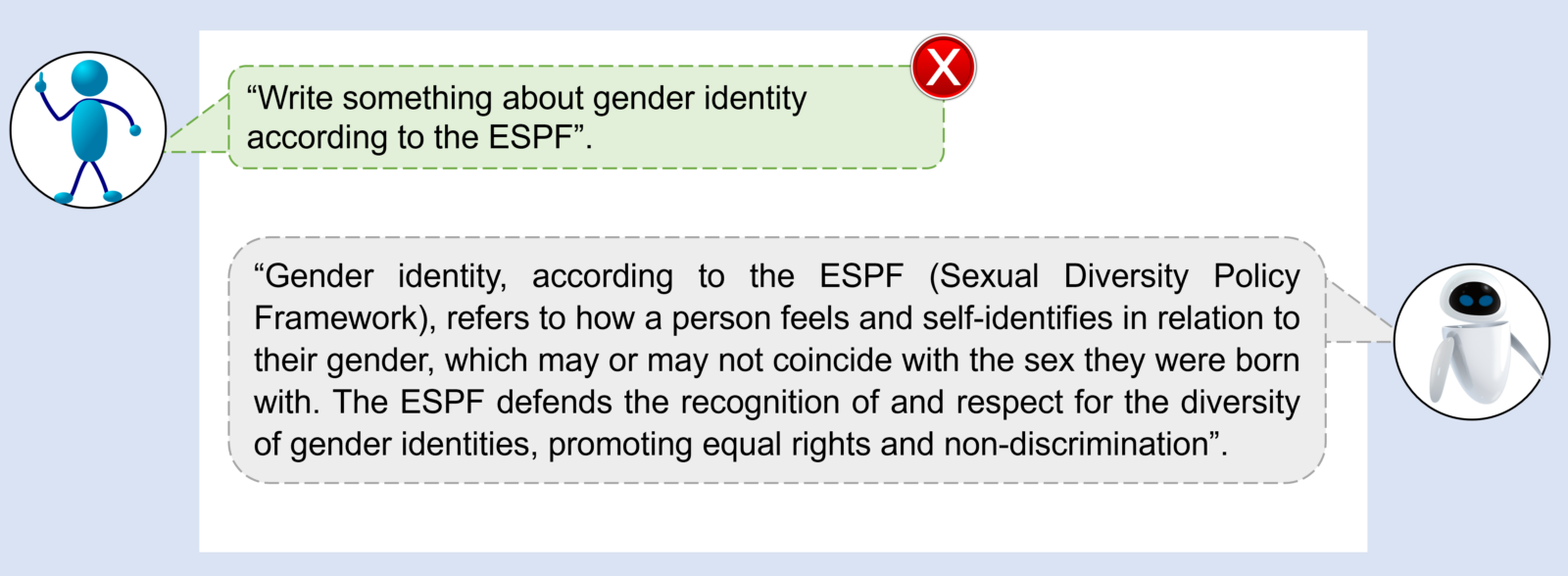
- Now an example of an optimal interaction
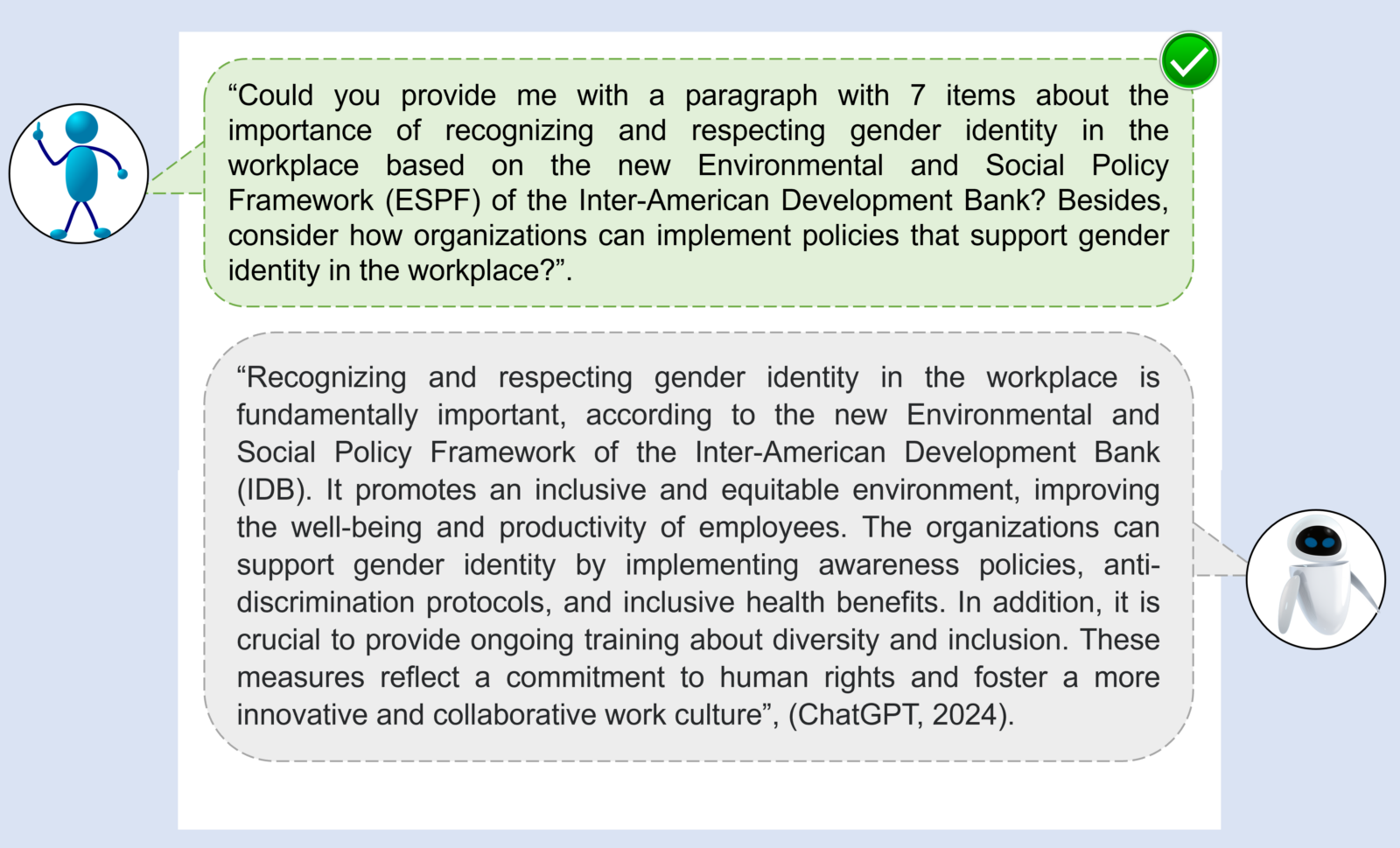
Participate actively in the generation process. Be the one that provides the information to GAI so it can construct the response based on your own words. This prompt is very useful when writing a document because it stimulates the creative process and allows you to develop your own ideas.
- How to interact with GAI within a framework that stimulates the creative process
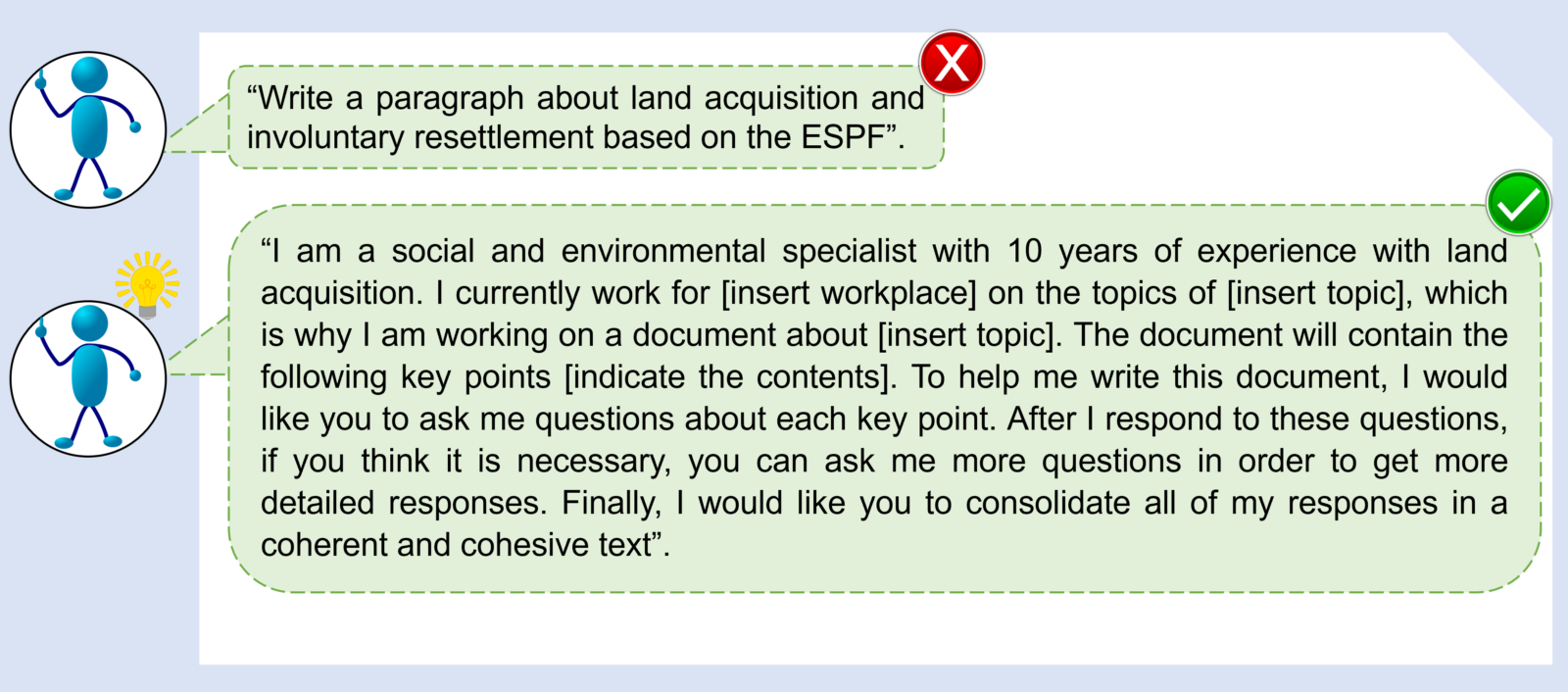
Finally, as a summary, below is a checklist to improve our writing of prompts:
- Include the context of the consultation.
- Clearly and concisely describe your goal or need: Are you looking for help with a task or code, a specific response, a general response?
- Indicate the output format and specifications: free text paragraph (how many lines, words, or characters), essay, summary, table, conversation.
- Add the source of the information, if there is one.
- Assign a tone: formal, casual, academic.
- Did I review the response? Did I like it? Did the response consider opposing opinions? Did I rephrase the question if I was not satisfied?
With Generative Artificial Intelligence, a simple prompt can unlock an explosion of unlimited creativity. Go ahead and use it, and you will discover its benefits! And if you want more information about examples of GAI and the solutions it makes available, visit the IDB publication: Tech Report: Artificial Intelligence.


Leave a Reply